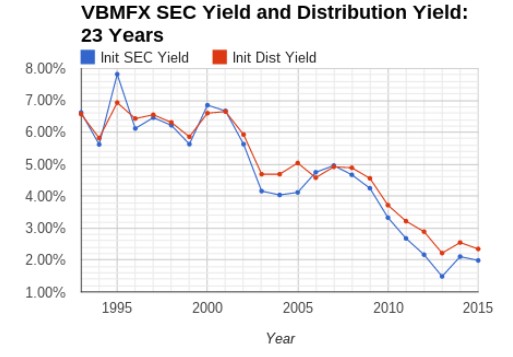Lsbcal
Give me a museum and I'll fill it. (Picasso) Give me a forum ...
I sold my investment grade short term bond fund (VFSUX) in early January. I knew it would be a good idea to buy it back at some time. Maybe this is about a decent time to wade back in? VFSUX now yields about 3.9% for a duration of 2.7 years.
I'm thinking maybe to do this buy back after the Fed FOMC meeting starts on July 26. Last FOMC meeting VFSUX went down that first day July 26 and then went up after the Powell announcement on July 27. The announcement is before the market closes on the 27th. And yes, such fine tuning may be unnecessary.
Here is a decent article from a Schwab person titled "Fed Rate Hikes: why are bond yields falling?" https://www.schwab.com/learn/story/fed-rate-hikes-why-are-bond-yields-falling?cmp=em-XCU
Some excerpts:
I'm thinking maybe to do this buy back after the Fed FOMC meeting starts on July 26. Last FOMC meeting VFSUX went down that first day July 26 and then went up after the Powell announcement on July 27. The announcement is before the market closes on the 27th. And yes, such fine tuning may be unnecessary.
Here is a decent article from a Schwab person titled "Fed Rate Hikes: why are bond yields falling?" https://www.schwab.com/learn/story/fed-rate-hikes-why-are-bond-yields-falling?cmp=em-XCU
Some excerpts:
Economic growth is slowing
Gross domestic product (GDP) growth contracted in the first quarter, driven primarily by a drop in consumption. Since consumer spending comprises about 70% of GDP growth, a slowdown in spending is concerning. Early indications point to a risk that Q2 GDP growth was also likely weak. Two negative quarters of GDP growth isn't the official definition of recession, but it signals that the indicators are pointing in that direction.
...
Inflation expectations discounted in TIPS market have fallen
...
Falling commodity prices
...
How low can they go?
With headline inflation still high, it may be hard for bond yields to fall much below 2.75% in the near term. However, it also appears that the 3.5% level reached in June could mark the high for the year. If recent economic trends continue, it would not be surprising to see 10-year Treasury yields fall further in the second half of the year, perhaps as low as 2.5%. That may prompt the Fed to slow its pace of rate hikes and/or alter its tightening plan later in the year. However, it may seem counterintuitive, but the more the Fed "front loads" its rate hikes and runs the risk of triggering a recession, the lower bond yields can fall.
We suggest investors looking to add more yield to their portfolios consider adding more duration—exposure to interest rate risk—to their portfolios with bonds that have low credit risk, such as Treasuries and investment-grade corporate and municipal bonds. A bond ladder strategy can be an effective way to average into the market.

